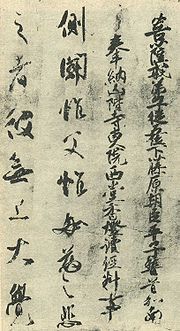
Tachibana no Hayanari
Encyclopedia

was a Heian period
Heian period
The is the last division of classical Japanese history, running from 794 to 1185. The period is named after the capital city of Heian-kyō, or modern Kyōto. It is the period in Japanese history when Buddhism, Taoism and other Chinese influences were at their height...
Japanese government official, calligrapher, and member of the Tachibana family. He travelled to China in 804, returning in 806. He died while traveling to exile in Izu Province
Izu Province
was a province of Japan in the area of Shizuoka Prefecture. Izu bordered on Sagami and Suruga Provinces. Its abbreviated form name was .The mainland portion of Izu Province, comprising the Izu Peninsula is today the eastern portion of Shizuoka Prefecture and the Izu Islands are now part of...
for supposed participation in an imperial succession controversy. His most famous remaining calligraphic work is the Ito Naishin'no Ganmon (伊都内親王願文), now in the Imperial Household collection. He is honored as one of the group of three outstanding calligraphers called Sanpitsu
Sanpitsu
The term Sanpitsu or "three brushes" is used in Japanese to refer to a group of three famous Heian period calligraphers:*Emperor Saga 嵯峨天皇, 786–842.*Kūkai 空海, 774–835.*Tachibana no Hayanari, 橘逸勢 c...
(Three Brushes).

